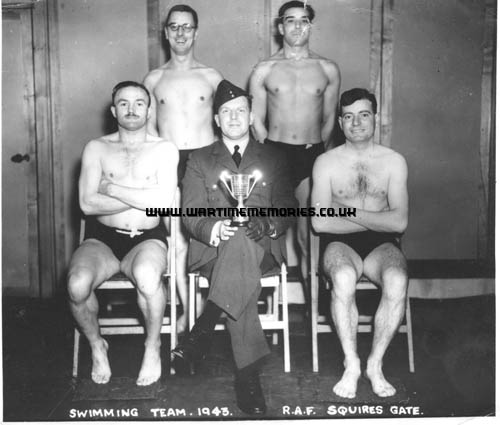|
|
|
RAF Squires Gate, Blackpool
RAF Squires Gate was also called RAF Blackpool. The site has been used for aviation meetings since 1907. During the Great War a hospital was built on the site. Between teh wars the area was again used for flying with an airport being built in 1933.
At the outbreak of war the site was taken over by the RAF, with 63 Squadron flying Battles and 75 and 215 Squadron with Wellingtons. The Ministry of Aircraft Production built a Vickers Wellington shadow factory in 1940 2,584 Wellingtons were built on the site which closed in October 1945. A secondary assembly line was also set up at Stanley Park across the road.
Blackpool became the RAF's largest training area with camps at Weeton and Kirkham.
Today the site is used as Blackpool Airport and houses industry and a shopping centre
Squadrons stationed at RAF Squires Gate
- No: 63 Squadron. September 1939 to January 1940
- 75 Squadron. September 1939 to January 1940
- No: 215 Squadron. September 1939 to January 1940
- No: 3 School of General Recconnaissance. Dec 1940
- No: 96 Squadron.
- No: 256 Squadron
9th September 1939 144 Squadron Air Firing Practice Commences
17th September 1939 144 Squadron Air to Air Firing Practice at Squires Gate Ranges
21st September 1939 144 Squadron - Squadron Leader J.C. Cunningham Promoted to Wing Commander
22nd September 1939 144 Squadron Formation Practice Commences
2nd Oct 1939 Training
29th Nov 1939 Training
If you can provide any additional information, please add it here.
|
Those known to have served at RAF Squires Gate, Blackpool during the Second World War 1939-1945. The names on this list have been submitted by relatives, friends, neighbours and others who wish to remember them, if you have any names to add or any recollections or photos of those listed,
please
Add a Name to this List
|
|
|
The Wartime Memories Project is the original WW1 and WW2 commemoration website.
Announcements
- The Wartime Memories Project has been running for 24 years. If you would like to support us, a donation, no matter how small, would be much appreciated, annually we need to raise enough funds to pay for our web hosting and admin or this site will vanish from the web.
- 18th April 2024 - Please note we currently have a huge backlog of submitted material, our volunteers are working through this as quickly as possible and all names, stories and photos will be added to the site. If you have already submitted a story to the site and your UID reference number is higher than 263925 your information is still in the queue, please do not resubmit, we are working through them as quickly as possible.
- Looking for help with Family History Research?
Please read our Family History FAQ's
- The free to access section of The Wartime Memories Project website is run by volunteers and funded by donations from our visitors. If the information here has been helpful or you have enjoyed reaching the stories please conside making a donation, no matter how small, would be much appreciated, annually we need to raise enough funds to pay for our web hosting or this site will vanish from the web.
If you enjoy this site
please consider making a donation.
Want to find out more about your relative's service? Want to know what life was like during the War? Our
Library contains an ever growing number diary entries, personal letters and other documents, most transcribed into plain text. |
|
We are now on Facebook. Like this page to receive our updates.
If you have a general question please post it on our Facebook page.
Wanted: Digital copies of Group photographs, Scrapbooks, Autograph books, photo albums, newspaper clippings, letters, postcards and ephemera relating to WW2. We would like to obtain digital copies of any documents or photographs relating to WW2 you may have at home. If you have any unwanted
photographs, documents or items from the First or Second World War, please do not destroy them.
The Wartime Memories Project will give them a good home and ensure that they are used for educational purposes. Please get in touch for the postal address, do not sent them to our PO Box as packages are not accepted.
World War 1 One ww1 wwII second 1939 1945 battalion
Did you know? We also have a section on The Great War. and a
Timecapsule to preserve stories from other conflicts for future generations.
|
|
Want to know more about RAF Squires Gate, Blackpool? There are:6 items tagged RAF Squires Gate, Blackpool available in our Library There are:6 items tagged RAF Squires Gate, Blackpool available in our Library 
These include information on officers, regimental histories, letters, diary entries, personal accounts and information about actions during the Second World War. |
|
Frederick Leonard Civilian Instructor I have always been led to believe that my father, Frederick Leonard was a civilian driving instructor at RAF Squires Gate during the 1939-45 conflict.
We moved to Blackpool and stayed in a house near a park, my father went to work daily and mother looked after me. We made friends with the people who owned and ran a theatre in Blackpool, and when we returned to London, my father bought their house which was in South London. Hope someone can put some light on these memories for me
|
F/Sgt. W. S. "Jock" Marshall 608 sqd (d.27th May 1942) My Uncle, Flt/Sgt W. S. "Jock" Marshall was posted to 608 North Riding Squadron R.A.F. Station Thornaby, Yorkshire on the 25th September 1940. Flying Duties, Coastal Command. According to Service Record at Thornaby until 7th December 1940 He was then moved to No.3 School of General Reconnaissance at R.A.F. Squires Gate Lancashire. Jock and his crew were lost over the Channel on 27th May 1942 Any more information would be welcomed. His memory lives on with 608 Sqdn.
|
LAC William Fenton My father, William Fenton was at RAF Predannack in Cornwall. He was an LAC and worked on Lancasters. He was also a great sportsman and played football. My father was also at RAF Padgate and RAF Blackpool. I have many photos of him and his team and also taken with his CO. Does anyone remember him?
|
Jack Crapp RAF Blackpool I am looking for information about Jack Crapp who was stationed with the RAF at Blackpool during WWII. Before the war he played cricket for Gloucestershire and afterwards played for England in a number of Test Matches.
|
Dorothy Farrow Bomber Command My mother, Dorothy Farrow, served as a WAAF radio operator in Bomber Command from 1941 to 1945. She served at Elsham Wolds, Binbrook, Scampton and Bawtry Hall. I believe she trained at Blackpool.
|
Ronald Binge RAF Squire's Gate Ronald Binge, together with Sidney Torch, served at RAF Squire's Gate/Blackpool during WWII. They both performed in a concert/dance band in the RAF.
|
Sidney Torch RAF Squire's Gate Sidney Torch, together with Ronald Binge, served at RAF Squire's Gate/Blackpool during WWII. They both performed in a concert/dance band in the RAF.
|
Flt.Sgt. Joseph Thomas "Jock" Barclay 466 Squadron 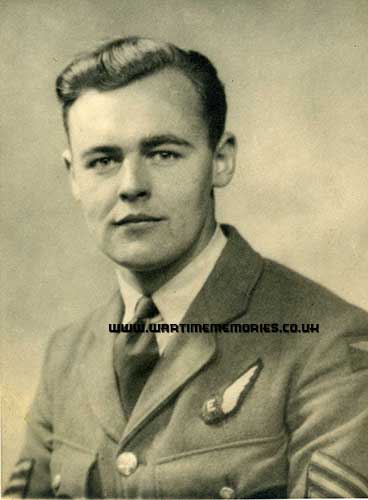  On reaching my eighteenth birthday I had to register for National Service and as my father had served in the Navy during World War One and my younger brother, Danny, was already at sea in the Merchant Navy, I looked forward to serving in the Navy also. However, I was very dismayed to find I had been placed on the Reserved Occupation Register and was destined to work on munitions for the duration of the war. Later I heard that if I volunteered for aircrew duty in the Royal Air Force I could get away to war if I passed the examinations and so with some other apprentices we volunteered and I'm glad to say I passed for pilot training. However, the selection board suggested that, as I was engineering trained, there was a new aircrew trade which took half as long as pilot training so I opted for that.
At that time there was an outbreak of typhoid in Scotland so I was put on deferred service. I then left the Home Guard and joined the Air Training Corp whilst waiting to be called up. Meanwhile, I attended the ATC in the building that was later Bellevue Secondary School where I got some Navigation, Morse training etc.
In the interim period I was sent to the old Waverley Market and employed in modifying the famous jeeps, working ten hour shift on constant nights when after six weeks I was told to report to Padgate Induction Centre and from Padgate to Blackpool South Shore for basic training which included drill, sports, square bashing, rifle range then to the school at Squires Gate training school for the Flight Mechanics course which lasted approximately three months before being posted back to Squires Gate again for the Fitters to Engines course, again for approximately three months with periods of Sentry Duty etc then from there onto RAF St. Athan, Glamorgan in Wales whilst waiting to join the Flight Air School. I was then aged twenty.
Whilst waiting we were drilled for one week in order to attend the Military Funeral of two Canadian Airmen who had crashed on the Welsh mountains and were laid to rest in St Athan.
Once we completed our training at St Athan we were lined up and told that if anyone didn't want to go on to train for the Flight Engineers course, which meant, of course, that you would be in the front line conflict, you could choose instead to stay on and train as an Engine Fitter which meant that you would be working as Ground Crew.
Along with most others I decided to go ahead with the Flight Engineers Course since I was really keen to fly. We had been made aware of the potential danger of flying but most of the men stayed in line like myself. It was then that my Mother realized what a dangerous job it was and made me a wee kiltie doll as a lucky charm which I kept in the pocket of my uniform every time that we flew. However, some one stole it.
I went sick with impetigo so lost the crew I'd had been training with. When I recovered I was posted to a conversion unit at Marsden Moor where there were airmen who were already trained and that is where I met Andrew Currie from Glencorse in Midlothian.
We had to find our own air crew to fly with and when Andrew & I were at the Mess waiting for dinner to be served we spotted two Australian crew so asked them if they looking for Flight Engineers which they were and that is how I became part of 466 Squadron (RAAF) together with Fred Pope (Pilot), John Downs (Navigator), Charlie Wilson (Bomb Aimer), Tom Roe (Wireless Operator), Nick Hewitt (Rear Gunner), Ed Dalton (Mid Upper Gunner) an all Australian Air Crew and myself!
And so began my Tour of Service which in the October and November of 1943 began with dual circuits, three engine flying and two engine flying practice, Solo Fighter Affiliation etc and by early December we were Bombing and Firing quickly followed by a bomb load to X country.
By early January 1944 we were involved in Air to Sea firing and by mid February Ops to Berlin.
By the end of March we had flown to Stuttgart, Fighter Affiliation 2 Spitfires, Keil Harbour Mining, Berlin Bombing, Essen Bombing, Nuremburg Bombing.
By this time my friend, Andrew Currie, together with all his crew, had been shot down and killed. They had only been flying for about three weeks or so.
April 1944
- Ottignes Bombing 11,000lb H.E. three motor landing
- Dusseldorf Bombing holed by flak
- Villeneuve St Georges Bombing
- Aulnoye, France Bombing
- Acheres Bombing.
May 1944:
- Marlenes, Belgium Bombing
- Mantes, Gassicourt Bombing
- Mosalines, France Bombing
- Mosalines, France Bombed Coastal Defence Installations.
- Hasselt, Belgium Bombed Marshall Yards. Fighter Attacks
- Boulogne Marshall Yards.
- Practice Bombing: DCO
And so it continued..
- Colline Baumont Gun Battery
- Ops. Bourg Leopold Army Barracks.
June 1944
- OAmiens Railway Junction
- Evercy Troop Concentration
- Sterkrade ( Ruhr ) Bombed on 3 engines
- St.Martin L'Hortier Siracourt heavy flak
- Oismont/Neuville-Au-Bois, France
- Le Grand, Rossignol, France
- D.N.C.O Port Inner feathered
.
July 1944
- Oismont - Neuville Bois (P. Plane Base)
- Marquise Mimoyecques
- Les Landes Vielles St Neuves:
- Sannerville ( Second Front)
- Ardouval France.
August 1944
- The Chapelle Notre Dame but unable to bomb, landed at Marsden. Marsden Moor to Base:
- L'Isle Adam near Paris and Foret De Nieppe, near Lille.
By then we had completed the expected length of a Tour and survived, unlike many of our Compatriots.
We were then asked to continue on and fly as a Transport Plane. In this capacity and for the next fourteen months until my discharge on the 1st October 1946 I flew to - Algiers,
- the Azores,
- Morroco,
- USA (New York, Washington, Dallas, Nashville, San Diego),
- Canada (Nova Scotia, Montreal), Newfoundland (Gander),
- Egypt (Cairo & Rabat),
- Labrador (Goose Bay),
- Iceland (Reykjavick),
- Mid Pacific (Canton),
- Fiji Island,
- Australia (Sydney),
- New Zealand (Auckland)
- Scotland (Prestwick).
I saw the world which I would not otherwise have seen. From there back to Civvie Street to complete my Engineering Apprenticeship with the New Welding and Engineering Company based in Annandale Street, Edinburgh where I remained all my working life rising through the ranks, first to Foreman then to Works Manager until I retired in March 1988 aged 65 years of age. I am writing this now aged 91. Joseph Barclay.
|
Cpl. Joyce Enid Freeman Joyce Enid Freeman , was my mother. She joined the WAAF in 1940 at the age of nearly 18. She lied about her age but was accepted because her birth certificate was mislaid and by the time it appeared she was just 18. Her first posting was as a maps clerk in Plymouth, underground. Her next posting was at Liverpool which was also severely bombed. Next posting was at Squires Gate which was at the time an RAF Home Command station. She again served as a maps clerk this time at the rank of Corporal. She told me that she had a tea fiddle going for the officers, not for financial gain, but because tea was very short then. One story was that a friend of hers witnessed the death of an airman on site when he walked in to a propellor and was decapitated, this had a most dramatic effect physiologically. Joyce kept in touch with my father, Norman Francis Saul, who was abroad serving in 2nd Battalion, Parachute Regiment. Not having seen each other for over 3 years they actually got engaged through the post. She spent her leave time visiting her parents near Bristol as her father was attached to an anti aircraft position there.
|
F/Lt. John Edwin Lewington This photograph shows the RAF Squires Gate Swimming Team 1943. I know the clothed figure is John Lewington, does anyone know who the other men are?
|
Gnr. John Francis Nolan 4th Medium Regiment, 9/13th Battery Royal Artillery My father, Frank Nolan, served with the 9/13th Medium Battery, 4th Medium Regiment, Royal Artillery in the BEF in 1939-40.
He joined the Aeronautical Inspection Directorate in March 1942, after 14 months in 3 military hospitals and being invalided out of military service after severe wounding at Dunkirk; he was a motor mechanic/ fitter. He served with the Aeronautical Inspection Directorate at Vickers Armstrong, Squires Gate from 14th of August 1944 to 13th of August 1945.
I have two photos of AID staff under a Wellington bomber's wing. One has signatures on the reverse, and my father is in both photos. I have two other small domestic photos taken at the time, one showing my mother and father at the beach, the other me (2 yrs. old); we are eating an ice cream, a wartime treat! Finally, I have two photos (or really a double one), taken by a typical seaside pavement photographer, of my father and another male AID Examiner.
|
ACM. Arthur Lionel Murch No. 215 Squadron 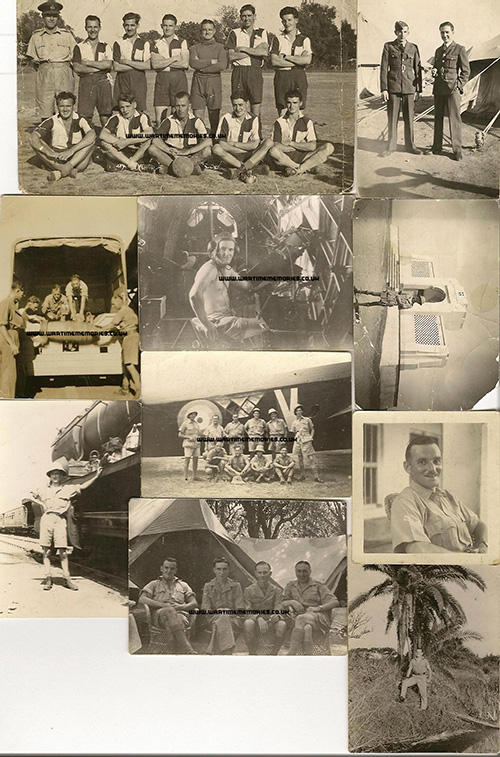 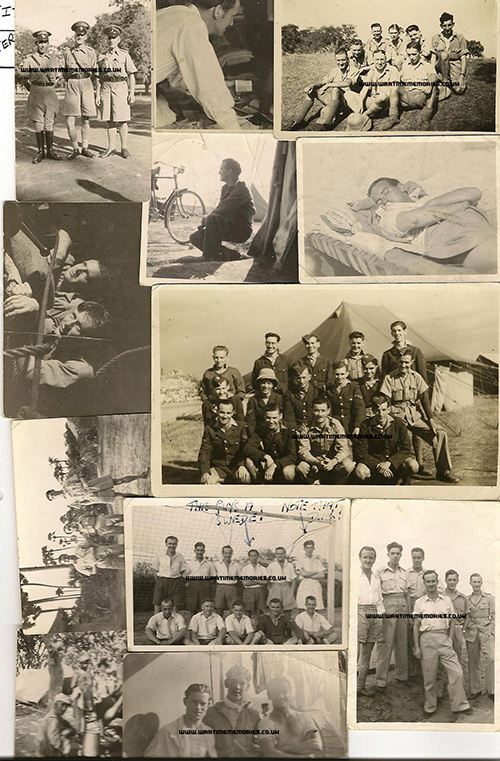 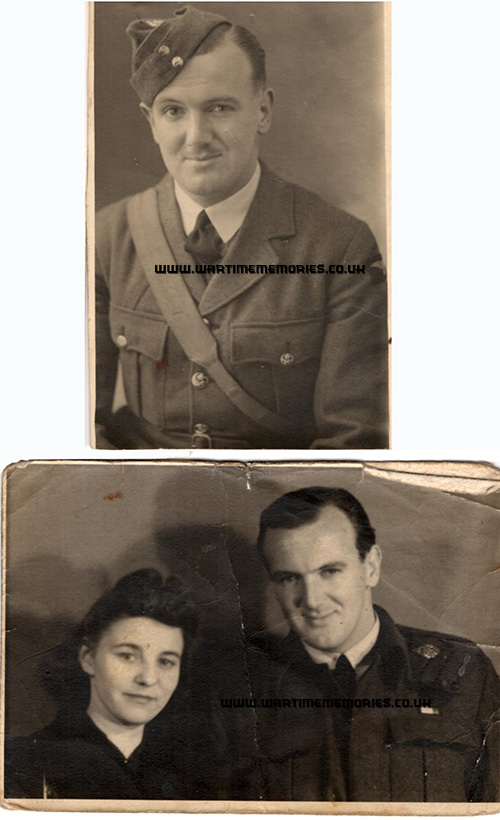 My dad, Arthur Murch, served with 215 Squadron in India and the Far East during WW2. He was born in Bristol on 24 November 1919, and died as a result of a hit-and-run incident in Shrewsbury, Shropshire in 1970.
He enlisted at RAF Cardington on 11th of October 1940, and then went to RAF Blackpool for training. He is down on his RAF Record of Service as W/Mech, initially on Wellington Bombers. He was admitted to Weavins Home, Poulton on 29th of January 1941 and discharged on 17th of February 1941 (it’s difficult to discern the writing on his record for this). He joined 215 Squadron sometime in 1941 and was posted to the Far East on 12th of February 1942. He was again admitted to BMH Asansol on 24 July 1942, and discharged on 29th July 1942. He was then admitted to BMH Lucknow and BGH Calcutta in 1943. Following this, he was then admitted to hospitals at Innsworth and Cranwell in 1945.
I have only recently requested his service record and I am awaiting any information regarding awards from the MoDMO. I hope to do further research in the near future.
|
Recomended Reading.Available at discounted prices.
|
|
|






